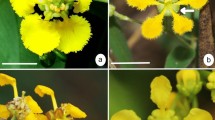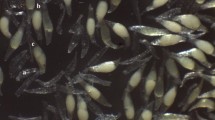Abstract
Aspects of reproductive ecology have been studied in two species ofPotentilla (Rosaceae) from interior Alaska. Data were collected to determine mating system traits such as seed: ovule and pollen: ovule ratios, and experiments were carried out in the field in order to study the effect of caging, emasculation, and manual self-pollination on seed set and seed quality. Mating system strategies differ between the two species in the populations examined. High pollen: ovule ratio, high seed: ovule ratio, good autodeposition ability, and unpredictable pollination in concert with self-incompatibility indicate thatP. hookeriana in the population studied has adopted a more or less pseudogamous mating system. In contrast, the data suggest thatP. uniflora in the studied population is approaching a sexual, facultatively outbreeding species. Because both species exhibit ploidy variation, a trait common among agamospermous plants, it is concluded that both species are likely to be facultatively agamospermous but that sexual reproduction is much more important in the population ofP. uniflora than it is inP. hookeriana.
Similar content being viewed by others
References
Acharya Goswami D. &Matfield B. (1974): Pseudogamy in the genusPotentilla L.New Phytol. 73: 1243–1247.
Asker S. (1977): Pseudogamy, hybridization and evolution inPotentilla.Hereditas 87: 179–184.
Barrett S. C. H. (1988): The evolution, maintenance, and loss of self-incompatibility systems. In:Lovett Doust J. &Lovett Doust L. (eds.),Plant reproductive ecology, Oxford University Press, New York, pp. 98–124.
Campbell C.S. &Dickinson T.A. (1990): Apomixis, patterns of morphological variation, and species concepts in subfam.Maloideae (Rosaceae).Syst. Bot. 15: 124–135.
Cideciyan M.A. &Malloch A.J.C. (1982): Effects of seed size on the germination, growth and competitive ability ofRumex crispus andRumex obtusifolius.J. Ecol. 70: 227–232.
Cruden R.W. (1977): Pollen-ovule ratios: a conservative indicator of breeding systems in flowering plants.Evolution 31: 32–45.
Dickinson T.A. &Phipps J.B. (1986): Studies inCrataegus (Rosaceae: Maloideae) XIV. The breeding system ofCrataegus crus-galli sensu lato in Ontario.Amer. J. Bot. 73: 116–130.
Goldblatt P. (1981): Index to plant chromosome numbers 1975–1978.Monogr. Syst. Bot. Missouri Bot. Gard. 5: 440–442.
Goldblatt P. (1988): Index to plant chromosome numbers 1979–1986.Monogr. Syst. Bot. Missouri Bot. Gard. 23: 194–195.
Goldblatt P. &Johnson D.E. (1990): Index to plant chromosome numbers 1987–1989.Monogr. Syst. Bot. Missouri Bot. Gard. 30: 168–169.
Haskell G. (1960): Role of the male parent in crosses involving apomicticRubus species.Heredity 14: 101–113.
Hendrix S.D. (1984): Variation in seed weight and its effects on germination inPastinaca sativa L. (Umbelliferae).Amer. J. Bot. 71: 795–802.
Hultén E. (1968):Flora of Alaska and neighboring territories. Stanford University Press, Stanford.
Ietswaart J.H. &Kliphuis E. (1985): Hybrids between DutchTormentillae (Potentilla, Rosaceae).Acta Bot. Neerl. 34: 157–170.
Juzepczuk S. (1941): Rod 739. Lapĉatka—Potentilla. In:Komarov V. (ed.),Flora SSSR 10 (Flora of the U.S.S.R. 10), Moskva, Leningrad, pp. 78–223.
Kellogg E.A. (1990): Variation and species limits in agamospermous grasses.Syst. Bot. 15: 112–123.
Löve Á. &Löve D. (1948):Chromosome numbers of northern plant species. Ingólfsprent, Reykjavík.
Molau U., Carlsson M., Dahlberg A. &Hill Ö. (1989): Mating system and pollen-mediated gene flow inBartsia alpina.Oikos 55: 409–419.
Molau U. (1993): Relationships between flowering phenology and life history strategies in tundra plants.Arct. Alpine Res. 25: 391–402.
Morgan D.R., Soltis D.E. &Robertson K.R. (1994): Systematic and evolutionary implications of rbcL sequence variation inRosaceae.Amer. J. Bot. 81: 890–903.
Muniyamma M. &Phipps J.B. (1979a): Cytological proof of apomixis inCrataegus (Rosaceae).Amer. J. Bot. 66: 149–155.
Muniyamma M. &Phipps J.B. (1979b): Meiosis and polyploidy in Ontario species ofCrataegus in relation to their systematics.Canad. J. Genet. Cytol. 21: 231–241.
Müntzing A. (1928): Pseudogamie der GattungPotentilla.Hereditas 11: 267–283.
Müntzing A. (1931): Note on the cytology of some apomicticPotentilla-species.Hereditas 15 166–178.
Ramirez N. &Brito Y. (1990): Reproductive biology of a tropical palm swamp community in the Venezuelan Llanos.Amer. J. Bot. 77: 1260–1271.
Skalińska M. &Czapik R. (1958): Studies in the cytology of the genusPotentilla L.Acta Biol. Cracov., Ser. Bot. 1: 137–149.
Smith G.L. (1963a): Studies inPotentilla. I. Embryological investigations into the mechanism of agamospermy in BritishP. tabernaemontaniAschers.New Phytol. 62: 264–282.
Smith G.L. (1963b): Studies inPotentilla: II. Cytological aspects of apomixis inP. crantzii(Cr.) Beck exFritsch.New Phytol. 62: 283–300.
Soják J. (1985): Some new northern hybrids inPotentilla L.Preslia 57: 263–266.
Soják J. (1986): Notes onPotentilla. I. Hybridogenous species derived from intersectional hybrids of sect.Niveae×sect.Multifidae. Bot. Jahrb. Syst. 106: 145–210.
Sokal R.R. &Rohlf F.J. (1987):Introduction to biostatistics. Ed. 2. W.H. Freeman & Company, New York.
Svensson L. (1985): An estimate of pollen carryover by ants in a natural population ofScleranthus perennis L. (Caryophyllaceae).Oecologia 66: 373–377.
Temme D.H. (1986): Seed size variability: a consequence of variable genetic quality among offspring?.Evolution 40: 414–417.
Wiens D. (1984): Ovule survivorship, brood size, life history, breeding systems, and reproductive success in plants.Oecologia 64: 47–53.
Wolf T. (1908): Monographie der GattungPotentilla.Biblioth. Bot. 16: 1–714.
Author information
Authors and Affiliations
Rights and permissions
About this article
Cite this article
Eriksen, B. Mating systems in two species ofPotentilla from Alaska. Folia Geobot 31, 333–344 (1996). https://doi.org/10.1007/BF02815378
Issue Date:
DOI: https://doi.org/10.1007/BF02815378




